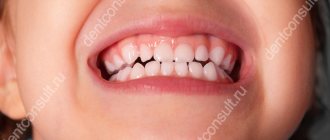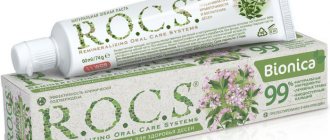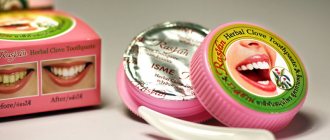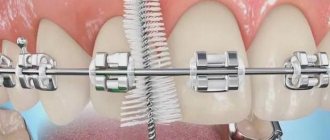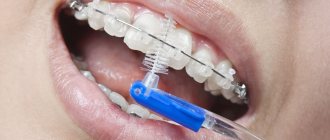Our enamel is constantly exposed to aggressive external factors, such as coloring products, coffee and tea, medications, and tobacco smoke. All this over time leads to a gradual change in the color of the teeth, the formation of abundant yellow plaque, which over time turns into hardened deposits that provoke the development of caries. Today, the Vita tooth color scale is actively used in dentistry - it is used to determine the shade of enamel, predict the results of whitening, and select the appropriate tone for filling materials. Later in this article we will talk about what this scale is, when it is used and how to use it correctly.
What factors determine the natural color of enamel?
Before moving on to the technique of using the Vita scale in dentistry, let’s consider what the natural shade of teeth depends on and what affects their color. Several factors play a decisive role in this issue, and here are the main ones:
- heredity,
- predisposition to certain systemic pathologies,
- level of hygiene,
- diet,
- condition and strength of bone tissue.
If we talk about what tone of teeth is considered normal, then we must immediately make a reservation that the enamel consists of approximately 97% of inorganic compounds. Therefore, its natural color is different for everyone, despite the fact that a person may not have any pronounced dental problems.
Heredity primarily determines the color of teeth
A change in the color of the enamel, its yellowing should be a good reason for concern and contact a specialist. After all, poor hygiene and plaque are not the only reasons for visible changes, and the real problem may lie much deeper. The reason may be not only dental disease, but also systemic pathologies.
Factors affecting shade
The tones of tooth enamel are individual, they are different for each person. The main factors influencing tone are:
- milk units are characterized by a perfectly white shade, since the enamel is still thin, it visually appears much lighter;
- a grayish tint is usually observed in teeth after depulpation, with fluorosis;
- the yellow tone is most common, it is associated with genetic factors, a thin layer of enamel through which dentin is visible, an increase in the yellow tint is characteristic of age-related changes, violations of hygiene rules, the darkest tone is observed in smokers;
- a brown tint appears with age-related changes; at a young age it is caused by food pigments, when taking drugs of the tetracycline group.
Before prosthetics, it is recommended to restore the natural tone. For this purpose, various bleaching methods are used, and office cleaning is carried out.
To clarify questions about dental restoration, please contact the specialists of the Denta-Labor clinic by calling (495) 162-08-25 . You can also make an appointment at a time convenient for you, for which you need to fill out an application on the website, spending just a couple of minutes.
For what reasons can the shade of teeth change?
A naturally perfect snow-white smile is quite rare. In addition to the fact that most people’s teeth have a slight yellowish tint from birth, throughout their lives they are constantly exposed to external factors that cause their color to change. Here are just the main prerequisites:
- improper and irregular cleaning,
- addiction to coffee, strong tea and other coloring drinks,
- smoking cigarettes,
- aging of the body,
- dental diseases,
- consumption of products with intense coloring pigments,
- lack of vitamins and microelements or their excess in the body,
- taking certain medications.
Constant exposure to external factors causes changes in the color of teeth
. To maintain the natural whiteness of a smile, you need to follow the rules of oral hygiene, respond in time to any suspicious changes, and regularly visit the dentist’s office for preventive examinations.
How to maintain results for a long time
After dentures or whitening, it is very important to keep the color of your smile natural. To do this, it is important to follow the recommendations for caring for dentures (if artificial crowns or veneers were installed) or directly for the teeth (after the whitening procedure).
As a rule, the main stages of care are daily oral hygiene, exclusion from food (at least for the first weeks) of coloring foods - berries, wine, strong tea or coffee, as well as quitting smoking.
Good to know! Bleached enamel becomes thinner, and therefore more sensitive, so to care for it you need special gentle pastes and brushes with soft bristles. Doctors also advise rinsing your mouth after every meal and using floss for high-quality cleansing.
The same goes for veneers and ceramic inlays. For example, it is not recommended to use electric ultrasonic toothbrushes if you have such microprostheses, since the high frequency of rotation or vibration of the brush head can heat the prosthesis or peel off the adhesive, which leads to deformation of the prosthesis or a reduction in service life.
Do not forget to visit the dentist once every six months so that he can monitor the condition of the oral cavity and dentures, adjust hygiene procedures, and also diagnose the presence of diseases, in particular caries, in a timely manner.
Vita scale - what is it?
The Vita scale is a ruler of visual perception of different shades of enamel, in which each tone is assigned an alphanumeric designation. This table is the most popular tool for determining the color of teeth in dentistry both in Russia and in European countries. The scale itself is divided into 4 groups: A, B, C and D. The palette includes 16 shades. As part of professional whitening or prosthetics, the specialist first evaluates the current clinical picture, after which he selects the closest shade from the proposed range.
On a note! In modern clinics, digital technologies are used for this purpose, for example, the Digital Smile Design program. This is innovative software that allows you to project the appearance of your smile after restoration and carefully plan the upcoming treatment, including determining the most suitable enamel tone. Images of the patient’s jaw system from different angles are loaded into the program, where they are further processed and the future smile is modeled.
The Vita scale can be presented in the form of a palette printed on thick laminated cardboard, plastic or paper. But the best option is a table with retractable acrylic microprostheses made of ceramics. This device is used when choosing the color of a composite material for artistic restoration, the shade of a future crown, in the manufacture of veneers and lumineers, and for whitening.
Thus, the scale offers the following palette of tones:
- A (1, 2, 3, 3.5, 4) – five options of red-brown shade,
- B (1, 2, 3, 4) – four subtones of red-yellow,
- C (1, 2, 3, 4) – four shades of gray,
- D (2, 3, 4) – three subtones of red-gray1.
The Vita scale can be presented in the form of a palette
Now about brightness: the higher the index, the dimmer the color. The lower it is, the lighter and brighter the samples will be. So, for example, under the designation A1 will be the lightest shade, while under A4 will be the darkest shade from this category.
Tone selection features
To accurately determine which shade of the crown will be as close as possible to the natural color of the patient’s teeth, the doctor conducts a test using the Vita scale (see the visual photo below). According to the Vita determination rules, the dentist first selects which of the 4 groups the patient’s enamel color belongs to, and then within this group begins to select shades that most closely match the color of neighboring units.
How tone is assigned
The Vita subtone number is assigned based on the decrease in whiteness: the higher the number (or index), the darker the enamel color will be. For example, an overlay from the palette marked as A1 is the “whitest”, and A4 is the darkest of group A. And this rule applies to all groups.
2. Why high technology doesn’t always help
You can often read negative comments on forums that computer technology is not used to determine tone. And although there are programs developed specifically for such a procedure, the most accurate is still a visual comparison of the patient’s crowns with the base table.
Interesting to know! An adequate assessment of color by a computer is influenced by many factors: the lighting in which the image loaded into the program was taken, the resolution and color sensitivity of the camera used to take the image, and the color calibration of the computer itself. And even if at some point there was a failure of a tenth of a percent, this may affect the final result, and the sample selected by the computer will turn out to be lighter or darker than necessary.
In addition, using programs to determine the color of crowns is more expensive than using the basic Vita table, which is why doctors most often resort to this method, especially in small dental offices. And it’s more convenient for patients to compare samples in person.
3. What conditions are necessary for high-quality diagnostics
Despite the fact that using the Vita scale is cheaper and gives more accurate results, it is important to observe certain conditions when testing:
- Before testing, you need to brush your teeth twice: once at home, immediately before the appointment, and the second time the doctor cleans it using special solutions. This is necessary in order to remove microplaque that forms daily on the enamel and can affect its color,
- It is recommended that the patient come to the appointment wearing clothes in neutral pastel colors and with an open neck so that the fabric does not contrast with the face and teeth. If a person wears white, black or other bright clothing, this may distort the doctor's perception,
- In the dentist’s office, it is important to create high-quality lighting: if testing takes place in the dark, dentists use powerful lamps or special frames with LEDs to simulate daylight, which are held by the doctor’s assistant or the patient himself during testing. For the accuracy of the procedure, it is important to fully illuminate all crowns,
- the patient must be healthy: the choice of color tone according to the Vita scale, as a rule, is carried out only on healthy units of the dentition and in the absence of any chronic acute diseases in the patient. This is done because any serious disease of organs and systems can affect the natural color of crowns,
- if the patient has teeth with different shades of enamel: here the doctor often recommends an intermediate shade or a decision is made to correct not just one tooth, but the entire smile area.
In what cases is the Vita scale used - recovery methods
The Vita color scale allows you to evaluate the actual shade of enamel and identify possible deviations from the norm. This is a kind of hint that helps to assess the current clinical picture. This tool is used before whitening, restoration, prosthetics, installation of veneers and lumineers. Here are the main options for restoring the natural whiteness and beauty of a smile, for which the Vita palette is usually used:
- professional hygiene – removal of plaque and tartar in the dentist’s office, allows you to eliminate pathological lesions at their very beginning, as well as restore the natural color of the enamel,
- home whitening is a set of techniques that involve the use of special gels, ointments, pastes, trays and pads impregnated with a whitening composition. Such techniques make it possible to lighten the enamel by several tones, but the effect cannot be called long-lasting,
- in-office whitening - photo whitening, laser, sandblasting, ultrasonic, intracanal, etc. Each technique has its own pros and cons, indications and contraindications. In any case, a professionally performed procedure allows you to achieve a pronounced and long-term effect,
- orthopedic restoration, including microprosthetics - this category includes artificial crowns, dentures, veneers and lumineers. Here we are talking not just about lightening the enamel, but also about correcting other defects, for example, chips and cracks, partially destroyed elements.
The scale allows you to evaluate and select the true shade of enamel
“When I was getting veneers, I had a lot of trouble with these colors. She herself is blonde and has fair skin, so there were specific problems with the choice of shade. At first one dentist suggested A1, but I thought it was a bit too much. As a result, with another doctor we settled on A2 - it looks more natural. In artificial light there is no feeling that your smile is porcelain. I’m very pleased that I went to another specialist and chose this option.”
NinaKom., Moscow, from correspondence on the woman.ru forum
The choice of a specific technique directly depends on the clinical picture, the desired effect, the cause of dental problems, as well as the financial capabilities of the patient. If it's just a matter of yellowed enamel, don't rush to self-medicate. Even before starting at-home whitening methods, you should consult with your dentist.
Reasons for changes in enamel color in children
- Some diseases of a pregnant woman: viral or bacterial infections of the mother’s body, as well as some medications (for example, tetracycline antibiotics) leave an imprint on the development of the fetus, including the formation of its tooth buds. This is fraught with the fact that the baby will erupt in units already with a defect (enamel hypoplasia or hyperplasia, tetracycline teeth, etc.),
- initial stage of caries: may change the color of milk crowns (white spots appear on them),
- fluorosis: a surplus of fluoride in a child’s body (due to the large consumption of fluoride-containing products, water, the use of toothpaste with a high content of this element) changes the color of the enamel, it becomes grayer and at the same time rough, brittle, with grooves,
- treatment with iron preparations: if they are used in liquid form, they cause temporary darkening of the tooth surface,
- constant consumption of coloring products: blueberries, bird cherry, sweets and drinks with artificial colors or based on red and blue berries.
Technique for determining color - how to choose the right shade
So, we found out that the Vita scale is used to determine what color a person’s teeth are and how to choose a shade during dentures or before lightening. But to correctly assess the condition of the enamel, the correct inspection technique is required. Below we will take a closer look at how the tone of teeth is determined and the shade closest to it is selected from the scale.
Preparing for a Smile Appearance Assessment
Before comparing enamel with the Vita palette, the patient must thoroughly clean his teeth of plaque and stone. However, more often than not this is not enough. Therefore, it is necessary to additionally carry out professional cleaning of dental plaque to restore the natural shade.
Before assessing color, you need to have your teeth professionally cleaned.
What factors influence color perception?
To properly assess tone, the inspection must be carried out under certain conditions. Thus, the results may be distorted due to incorrect lighting, poor quality of cleaning the enamel from plaque, the presence of foci of inflammation and other dental problems. Therefore, such diagnostics also require careful and attentive preparation.
Optimal conditions for the procedure
When answering the question of how to calculate how many shades your teeth have changed their color, you need to thoroughly clean them first. At the same time, fluorescent lamps must be installed in the dental office. The patient is advised not to wear bright clothes - it is better to give preference to calm pastel colors that will not create a sharp contrast.
The inspection must be carried out under certain conditions
Teeth whitening and restoration techniques
If even careful care and regular professional hygiene do not allow you to completely get rid of yellowness, teeth whitening comes to the rescue. In our articles, we have already examined in detail the advantages and disadvantages of office and home whitening.
When darkening of the teeth is caused by severe thinning of the enamel, dental disease, or a general deterioration in the patient’s health, the first step is to correctly diagnose the problem and carry out appropriate treatment. Afterwards, it is possible to restore your smile with the help of veneers, lumineers and crowns.
We recommend that you try your best to keep your teeth healthy.
Preventive measures
If over time your smile has yellowed, your teeth have become dull and stained, in some cases you can do without in-office whitening and veneers. To do this, it is enough to undergo a professional cleaning procedure in the dentist’s office and subsequently provide competent prevention:
- give up bad habits, reduce consumption of coffee, strong tea and coloring products,
- maintain a high level of hygiene, brush at least twice a day, rinse your mouth every time after eating, use floss,
- start treatment of emerging dental problems in a timely manner and undergo preventive examinations at least twice a year.
Using hygiene products will help preserve the color of the enamel.
If the cause of the darkening has more serious justifications, you will need to undergo a full diagnosis in order to identify the true causes of the problem and then work directly with them. Professional whitening, microprosthetics or installation of crowns/prostheses will help correct the aesthetic defect.
Restoring lost color
If initially the patient’s teeth were much lighter and brighter, but over time they began to darken and lose their natural shade, you can try to do without expensive whitening and restore the color yourself. Typically, the following techniques give a good effect, provided they are used regularly:
- Quitting bad habits and, first of all, smoking.
- Maintain good oral hygiene, including brushing with fluoride-free whitening toothpastes and rinsing.
- Regular visits to the dentist and timely dental treatment.
- At least temporarily avoid drinks and foods with dyes, caffeine and fluoride.
We should not forget about prevention, which is recommended even if the normal color of tooth enamel is preserved. If all the efforts made were in vain and the smile is still far from ideal, you can resort to more radical measures.
As a rule, we are talking about professional services that include dental cleaning with the removal of stones and accumulated plaque, as well as external or intracanal whitening, which is most often carried out using special chemical solutions based on hydrogen peroxide. The latter procedure is indicated primarily for those patients who have suffered periodontitis (traumatic), and its main disadvantage is the increased sensitivity of the teeth.
If you want to make your teeth perfectly white for the long term, then it is better to resort to installing veneers, lumineers or ultraneers. It should be noted that, in addition to aesthetic indications, such manipulations are relevant for patients whose teeth have darkened due to regular use of medications or after the installation of artificial materials (fillings) that caused a change in color.
What healthy children's teeth should look like
Healthy baby teeth should be white and slightly translucent. Their formation begins in the sixth week of intrauterine development, and by the time the baby is born, all 20 rudiments should already be fully formed and waiting in the wings. Here, a lot depends on the woman’s health during pregnancy, so the expectant mother needs to carefully monitor her condition, eat right, treat emerging health problems in a timely manner, and, if possible, avoid taking potent medications.
Healthy baby teeth should be white and slightly translucent
So, for example, long-term use of tetracycline antibiotics during pregnancy leads to pronounced staining of the dental tissues of both mother and baby. As a result, the enamel acquires a rather bright yellow tint, which is very difficult to lighten.
Where to get prosthetics?
Many clinics provide partial or complete prosthetics services. Find doctors based on reviews. Contact a clinic that has proven its professionalism through experience and work.
A doctor who knows his business will not rest until he brings his smile to perfection. The equipment of the clinic is important. Equipment in the hands of an experienced doctor works wonders. You will get what you expected.
As for the price, it depends on the case. Prices range from 1,700 rubles for simple crowns to 30,000 for lumineers or veneers. The procedure will cost 21,000 apiece.
What to do if your tooth color has changed
If a tooth suddenly darkens or acquires an uncharacteristic shade, it is probably due to pathological processes that require immediate help from specialists. You cannot delay with such a symptom - you need to contact a dentist as soon as possible so that he can assess the degree of deviation from the norm and diagnose the cause of the pathological phenomenon. A tooth can suddenly darken as a result of injury, the development of necrotic processes in the pulp area, or due to the presence of filling material containing silver, tin, mercury or zinc (obsolete materials).
Changes in enamel color indicate some pathological processes
If we talk about changing the color of the entire smile at once, then among the common prerequisites for the problem are work in the metallurgical industry, excessive consumption of coffee, strong tea, coloring products, smoking, taking powerful medications, and low levels of hygiene. In any case, such a situation requires increased attention and mandatory examination by a specialist. Even if it's all about poor hygiene or excessive coffee consumption, it's imperative to have a hygienic cleaning at the dentist's office. Otherwise, plaque will soon turn into hard deposits and become a prerequisite for the development of carious processes.
Current promotions!
I WANT COLOR A1
Option 1. You are lucky - your teeth are like this by nature.
Take care of them! Regularly undergo comprehensive hygiene procedures and, if possible, try to limit dyes. But nothing lasts forever, and neither does the natural whiteness of teeth. Most likely, this will go away with age, unfortunately.
Option 2. Bleaching. There are several methods, they may have different names, the equipment used and the price, but the principle is the same - the chemical effect on the enamel with derivatives of hydrogen peroxide, with or without the use of a light lamp.
Is it effective? Yes, but under certain conditions: firstly, there should be no fillings or restorations on the front teeth, otherwise they will become noticeable after the whitening procedure and will need to be redone. Secondly, over time, the natural color will return, and bleaching must be repeated. After whitening, teeth can become very sensitive, so much so that repeating the procedure will be impossible. Repeated bleaching severely damages the enamel.
Option 3. Artistic restoration using composite materials. This method is applicable if your teeth are not ideally shaped and have natural wear. The doctor can use light-colored material, but all teeth that are visible when smiling and talking must undergo restoration. The advantages of this “build-up” are that the method is quite gentle, but the disadvantages are a large amount of expensive work and a shortage of specialists who are fluent in this technique. And of course, like everything else, restoration is not eternal.
What is the relationship between enamel color and systemic diseases
Poor hygiene and dental diseases are not the only factors leading to darkening of the enamel. So, for example, such a nuisance can occur due to disruptions in fluoride metabolism in the body, with some systemic diseases and heavy metal poisoning. If we talk about dental pathologies, then fluorosis leads to the appearance of dark spots on the teeth, and the pulpless units completely darken from the inside.
Changes in the color of the enamel may indicate serious diseases of the body
If hard tissues have acquired a reddish tint, this may indicate internal disorders, such as rheumatism, porphyria, infectious pathologies: typhoid, cholera, dysentery. The condition of teeth also worsens with diabetes mellitus, as well as other disorders of the endocrine system.
Modern dental clinics offer all possibilities for correcting the shade of enamel: from professional and endodontic whitening to the installation of veneers or crowns. But it is better, of course, to initially maintain oral hygiene, monitor the health of your teeth and gums, and undergo regular preventive examinations with a dentist in order to protect yourself from many dental problems.
- Vavilyuk A A. Teeth whitening: what you need to pay attention to when choosing different systems, 2004.
A beautiful smile is the key to success!
Smile with us! The dentists at our Center will help you make your smile sparkling for a long time. The department is equipped with the latest technology and has everything necessary to perform high-quality work: a modern dental complex, high-quality X-ray equipment and the latest generation materials. Each patient is guaranteed high-quality treatment and an individual approach to teeth whitening. If, after whitening, you need to replace old fillings with defects with new ones or cure caries, all these problems can also be solved in our dental department.
Remember that beautiful teeth are your calling card in our modern world!
Advice from Dr. Zubastik
Don't like the color of your teeth? Don't worry, the problem can be solved. If you wish, you can buy a special set of mouth guards and lightening gel and lighten the enamel at home.
But first, consult your doctor: he may advise you to limit yourself to ultrasonic cleaning. In this case, the teeth will become half a tone whiter.
If it’s not enough, use a professional whitening service or install veneers. The main thing is that in pursuit of beauty, do not forget about dental health. Frequent bleaching weakens the enamel. Maybe it’s better to agree with what nature gave - after all, yellowish enamel is really a little stronger than ideal white?
Do you want to lighten your enamel? Watch how it happens:
Tags: Baby teeth, whitening, Teeth color, Vita scale
About the author: Dr. Zubastik
Typically, a toothache begins to subside on the way to the clinic and finally goes away after 10 minutes of sitting in line to see the dentist.
- Related Posts
- 10 foods that are good for your teeth
- Classification of caries: all types
- Is it possible to do an MRI with dental implants?
« Previous entry
